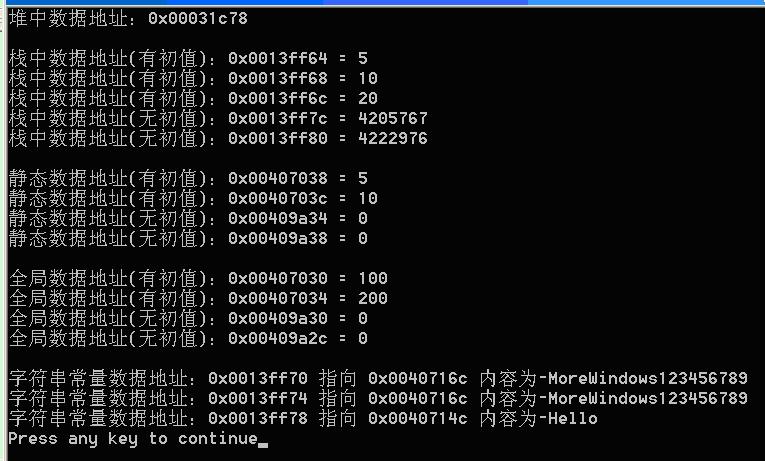C/C++變數在記憶體中的分佈
阿新 • • 發佈:2018-12-26
C/C++變數在記憶體中的分佈在筆試時經常考到,雖然簡單,但也容易忘記,因此在這作個總結,以加深印象。
先寫一個測試程式:
#include <stdio.h>
#include <malloc.h>
int g_i = 100;
int g_j = 200;
int g_k, g_h;
int main()
{
const int MAXN = 100;
int *p = (int*)malloc(MAXN * sizeof(int));
static int s_i = 5;
static int s_j = 10;
static int s_k;
static 執行結果(Release版本,XP系統)如下:

可以看出:
1. 變數在記憶體地址的分佈為:堆-棧-程式碼區-全域性靜態-常量資料
2. 同一區域的各變數按宣告的順序在記憶體的中依次由低到高分配空間(只有未賦值的全域性變數是個例外)。
3. 全域性變數和靜態變數如果不賦值,預設為0。 棧中的變數如果不賦值,則是一個隨機的資料。
4. 編譯器會認為全域性變數和靜態變數是等同的,已初始化的全域性變數和靜態變數分配在一起,未初始化的全域性變數和靜態變數分配在另一起。
上面程式全在一個主函式中,下面增加函式呼叫,看看函式的引數和函式中變數會分配在什麼地方。
程式如下:
#include <stdio.h>
void fun(int i)
{
int j = i;
static int s_i = 100;
static int s_j;
printf("子函式的引數: 0x%p = %d\n", &i, i);
printf("子函式 棧中資料地址: 0x%p = %d\n", &j, j);
printf("子函式 靜態資料地址(有初值): 0x%p = %d\n", &s_i, s_i);
printf("子函式 靜態資料地址(無初值): 0x%p = %d\n", &s_j, s_j);
}
int main()
{
int i = 5;
static int s_i = 100;
static int s_j;
printf("主函式 棧中資料地址: 0x%p = %d\n", &i, i);
printf("主函式 靜態資料地址(有初值): 0x%p = %d\n", &s_i, s_i);
printf("子函式 靜態資料地址(無初值): 0x%p = %d\n", &s_j, s_j);
putchar('\n');
fun(i);
return 0;
}執行結果如下:

可以看出,主函式中棧的地址都要高於子函式中引數及棧地址,證明了棧的伸展方向是由高地址向低地址擴充套件的。主函式和子函式中靜態資料的地址也是相鄰的,說明程式會將已初始化的全域性變數和表態變數分配在一起,未初始化的全域性變數和表態變數分配在另一起。
轉載請標明出處,原文地址:http://blog.csdn.net/morewindows/article/details/6851681
再分享一下我老師大神的人工智慧教程吧。零基礎!通俗易懂!風趣幽默!還帶黃段子!希望你也加入到我們人工智慧的隊伍中來!https://www.cnblogs.com/captainbed
